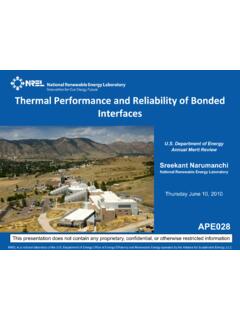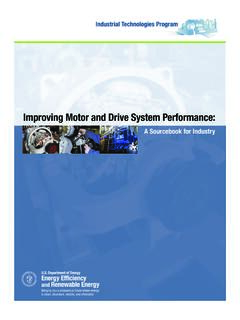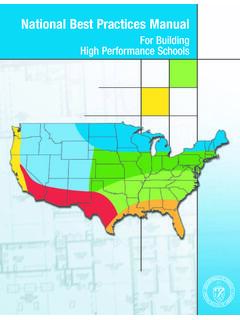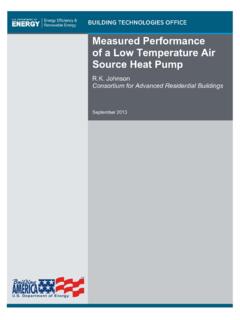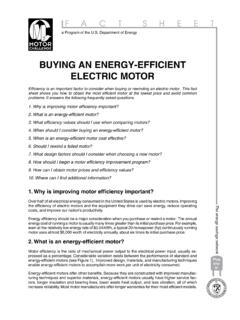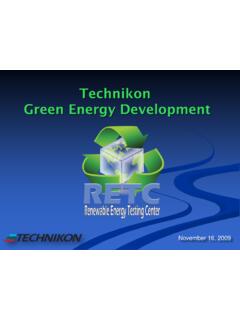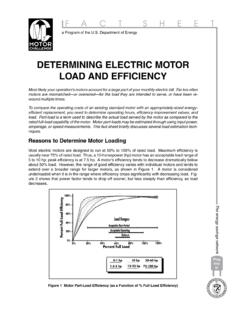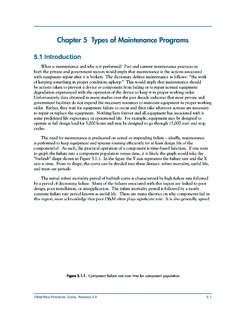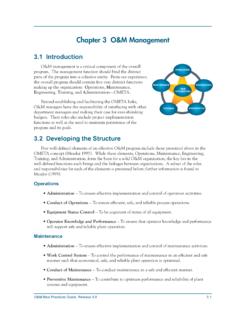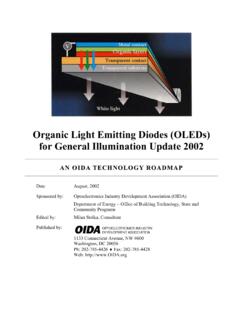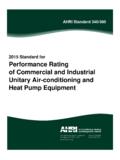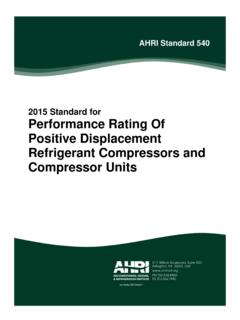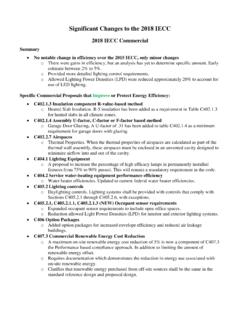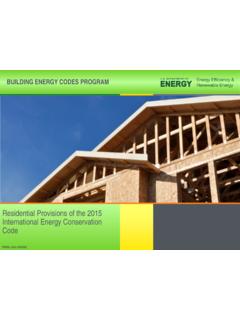Transcription of Measure Guideline: Ventilation Guidance for Residential ...
1 Measure Guideline: Ventilation Guidance for Residential high - performance New construction multifamily Joseph Lstiburek Building Science Corporation January 2017. NOTICE. This report was prepared as an account of work sponsored by an agency of the United States government. Neither the United States government nor any agency thereof, nor any of their employees, subcontractors, or affiliated partners makes any warranty, express or implied, or assumes any legal liability or responsibility for the accuracy, completeness, or usefulness of any information, apparatus, product, or process disclosed, or represents that its use would not infringe privately owned rights. Reference herein to any specific commercial product, process, or service by trade name, trademark, manufacturer, or otherwise does not necessarily constitute or imply its endorsement, recommendation, or favoring by the United States government or any agency thereof. The views and opinions of authors expressed herein do not necessarily state or reflect those of the United States government or any agency thereof.
2 This report is available at no cost from the National Renewable Energy Laboratory (NREL) at Available electronically at SciTech Connect Available for a processing fee to Department of Energy and its contractors, in paper, from: Department of Energy Office of Scientific and Technical Information Box 62. Oak Ridge, TN 37831-0062. OSTI Phone: Fax: Email: Available for sale to the public, in paper, from: Department of Commerce National Technical Information Service 5301 Shawnee Road Alexandria, VA 22312. NTIS Phone: or Fax: Email: Measure Guideline: Ventilation Guidance for Residential high - performance New construction multifamily Prepared for: The National Renewable Energy Laboratory On behalf of the Department of Energy's Building America Program Office of Energy Efficiency and Renewable Energy 15013 Denver West Parkway Golden, CO 80401. NREL Contract No. DE-AC36-08GO28308. Prepared by: Joseph Lstiburek, , Building Science Corporation 3 Lan Drive, Suite 102. Westford, MA 01886. NREL Technical Monitor: Stacey Rothgeb Prepared under Subcontract No.
3 KNDJ-0-40337-05. January 2017. iii The work presented in this report does not represent performance of any product relative to regulated minimum efficiency requirements. The laboratory and/or field sites used for this work are not certified rating test facilities. The conditions and methods under which products were characterized for this work differ from standard rating conditions, as described. Because the methods and conditions differ, the reported results are not comparable to rated product performance and should only be used to estimate performance under the measured conditions. iv Contents List of Figures .. vi Abbreviations .. viii Abstract .. 1. Progression Summary .. 2. 1 Introduction .. 3. 2 Decision-Making Criteria .. 4. Airtightness Requirements ..4. Ventilation Requirements ..4. Implications for multifamily Ventilation Design ..4. System Selection: Advantages, Disadvantages, and Costs ..6. 3 Technical Description .. 7. Purpose of Ventilation ..7. Uniqueness of multifamily Balanced Ventilation System Options.
4 11. Corridors, Elevator Shafts, and Trash Chutes ..18. 4 Measure Implementation .. 23. Climate-Specific Field System 1: Forced Air Outside Air to Return Side of Air Handler ..24. System 2: Forced Air Outside Air to Return Side of Air Handler, Supplemental Dehumidification ..25. System 3: Forced Air Heat Recovery Ventilator/Energy Recovery Ventilator ..26. System 4: Forced Air Heat Recovery Ventilator/Energy Recovery Ventilator, Supplemental Dehumidification ..27. System 5: Packaged Terminal Heat Pump Heat Recovery Ventilator/Energy Recovery Ventilator ..28. System 6: Packaged Terminal Heat Pump Heat Recovery Ventilator/Energy Recovery Ventilator, Supplemental Dehumidification ..29. System 7: Radiant Heating Heat Recovery Ventilator/Energy Recovery Ventilator ..30. 5 Verification Procedures and Tests .. 31. References .. 32. v List of Figures Figure 1. Only balanced Ventilation strategies are recommended for most multifamily construction .. 5. Figure 2. multifamily construction multifamily units share common surface areas with neighboring units.
5 Ventilation air should not be pulled from neighboring units, for fire- and smoke-control, odor-control, and general IAQ reasons .. 7. Figure 3. Common wall construction Common walls are required to meet fire and smoke assembly requirements .. 8. Figure 4. Floor assembly air sealing Floor assemblies that are soundproofed and fireproofed with liquid gypsum subflooring result in airtight wall assemblies at floor to wall connections . 8. Figure 5. Weatherstripped corridor doors Ventilation air is prohibited from being introduced into multifamily units from corridors; doors from multifamily units to corridors are typically weatherstripped .. 9. Figure 6. Passive air inlet Ventilation air can only be introduced into multifamily units by infiltration through exterior walls or directly into the units by ducted supply or passive air inlets (holes in the exterior walls) .. 9. Figure 7. Stack effect in a multistory building Stack-effect-driven airflows in multistory buildings compromise smoke control and fire safety, adversely affect IAQ and comfort and increase operating costs for space conditioning energy.
6 10. Figure 8. Stack-effect-driven airflow The air in lower units ends up in the upper units .. 10. Figure 9. Compartmentalization Basically, you turn a 10-story building into 10 one-story buildings that are stacked on top of one another; by isolating the units from each other and from corridors, shafts, elevators, and stairwells, stack-effect-driven interior airflows can be controlled .. 11. Figure 10. Distributed heating and cooling systems Each unit is conditioned individually .. 12. Figure 11. Distributed heating and cooling systems Each unit is conditioned individually .. 12. Figure 12. Individual supply and exhaust openings Multiple exhaust grilles and supply grilles are required .. 13. Figure 13. Individual unit space conditioning Each unit has its own air distribution system .. 13. Figure 14. Electric water heater Electric water heaters do not need to be vented to the exterior, whereas gas water heaters do .. 14. Figure 15. Gas water heater Gas water heaters should be sealed combustion two-pipe systems vented directly to the exterior with combustion air ducted directly to the water heater.
7 14. Figure 16. Clothes dryers Where clothes dryers are installed, they should be unvented condensing units or if vented to the exterior, a provision for powered make-up air must be made .. 15. Figure 17. Kitchen range hood It is recommended that make-up air be introduced below the cooking surface and that the range hood be wider and deeper than the cooking surface .. 15. Figure 18. Dehumidifier In return closet of forced-air system .. 16. Figure 19. Dehumidifier In ducted return system .. 16. Figure 20. Dehumidifier Located in return closet .. 17. Figure 21. Dehumidifier Located in closet with louvered 17. Figure 22. Corridor supply fan .. 18. Figure 23. Corridor conditioning .. 19. Figure 24. Elevator shaft smoke and hot gas vent .. 19. Figure 25. Corridor rooftop supply system .. 20. Figure 26. Preconditioning corridor supply .. 21. Figure 27. Trash chute Should be maintained at a negative pressure .. 22. Figure 28. Trash chute pressure control .. 22. Figure 29. Forced air Outside air to return to side of air handler.
8 24. Figure 30. Forced air Outside air to return to side of air handler, supplemental dehumidification .. 25. vi Figure 31. Forced air Heat recovery ventilator/energy recovery 26. Figure 32. Forced air Heat recovery ventilator/energy recovery ventilator, supplemental dehumidification .. 27. Figure 33. Packaged terminal heat pump Heat recovery ventilator/energy recovery ventilator .. 28. Figure 34. Packaged terminal heat pump Heat recovery ventilator/energy recovery ventilator, supplemental 29. Figure 35. Radiant heating Heat recovery ventilator/energy recovery ventilator .. 30. Unless otherwise noted, all figures were created by Building Science Corporation. vii Abbreviations ach air changes per hour ASHRAE American Society of Heating, Refrigerating and Air-Conditioning Engineers cfm cubic feet per minute ERV energy recovery ventilator HRV heat recovery ventilator HVAC heating, ventilating, and air conditioning IAQ indoor air quality ICC International Code Council IRC International Residential Code for One- and Two-Family Dwellings PTHP packaged terminal heat pump viii Abstract The Measure guideline provides Ventilation Guidance for Residential high - performance multifamily construction that incorporates the requirements of the ASHRAE Ventilation and indoor air quality standard.
9 The Measure guideline focus is on the decision criteria for weighing cost and performance of various Ventilation systems. The Measure guideline is intended for contractors, builders, developers, designers, and building code officials. The guide may also be helpful to building owners wishing to learn more about Ventilation strategies available for their buildings. The Measure guideline includes specific design and installation instructions for the most cost- and performance -effective solutions for multifamily unit Ventilation that satisfy the requirements of ASHRAE 1. Progression Summary multifamily The following outlines the steps to consider when designing and installing Ventilation multifamily building Ventilation systems. Identify project goals. Develop project goals with consideration 1 given to health and safety, climate zone, energy performance and cost, and any other project-specific criteria or constraints. IDENTIFY GOALS. Review building code requirements. Review the locally adopted 2 building code for health and safety, fire, and minimum energy performance requirements.
10 REVIEW CODES. Design. Decide on the Ventilation system best suited to the 3 project goals that will be required to implement the design. For moderate to large projects, consider engaging a qualified DESIGN. engineer to design the system. REVIEW CODES. construction . Plan the installation process, including 4 sequencing. construction . 2. 1 Introduction high degrees of enclosure air tightness and unit compartmentalization are fundamental components of high - performance multifamily construction and are now code required. Acceptable indoor air quality (IAQ) is also a fundamental component of high - performance construction , including requirements for dwelling unit mechanical Ventilation . However, dwelling unit Ventilation approaches that are compliant with ASHRAE Standard within enclosures constructed in accordance with the ICC 2015 International Residential Code (IRC) currently are not typical. Exhaust-only and supply-only Ventilation strategies can both be problematic in multifamily dwelling units that are constructed to meet the 2015 IRC or ASHRAE Standard air tightness requirements.
